The Complete Peloponnese Cycling Guide
Your complete Peloponnese cycling guide — discover ancient sites, olive groves, and scenic coastal roads on Greece’s most diverse and rewarding rides.
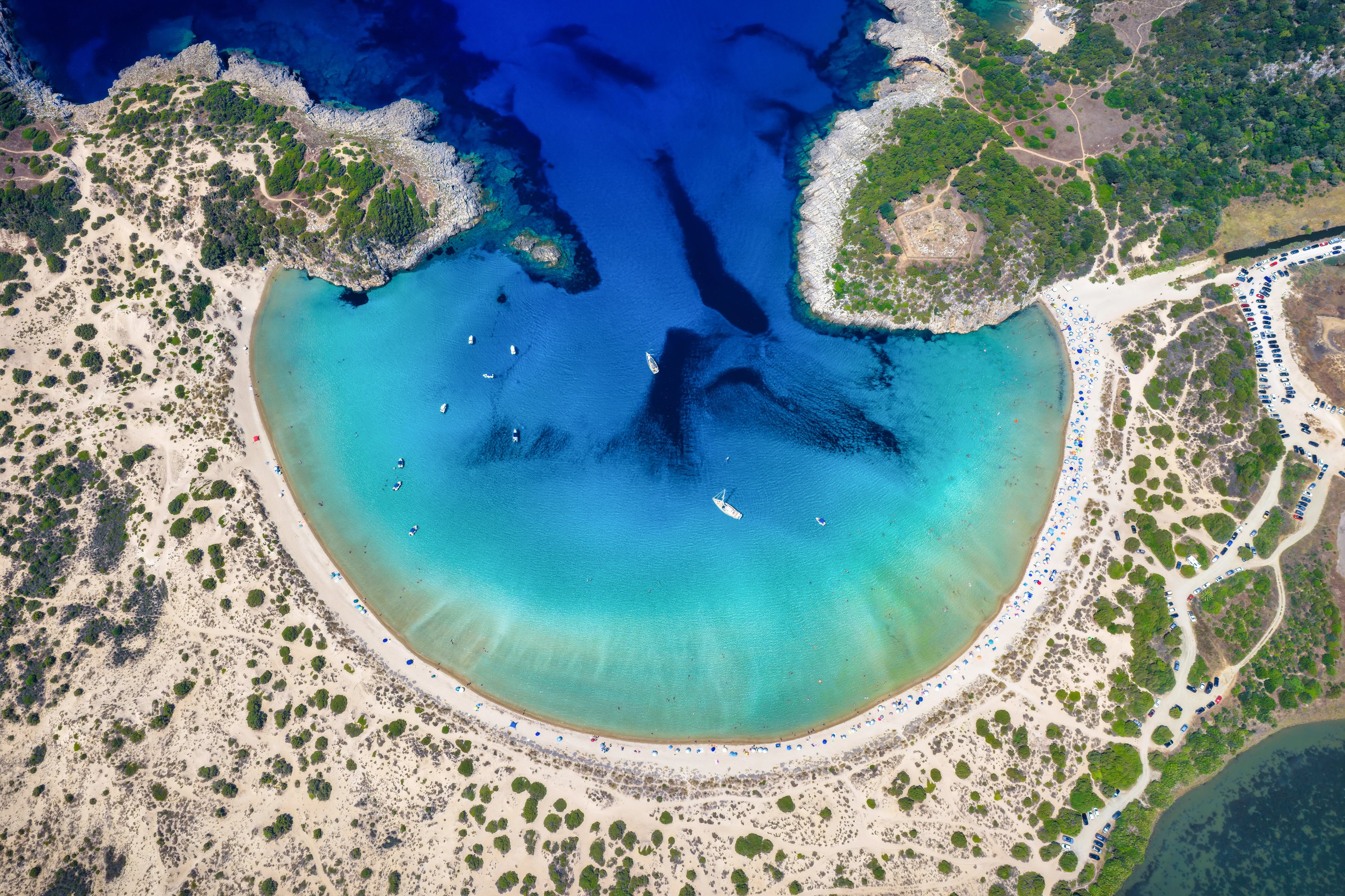
Quick links
The Peloponnese is the largest peninsula in Greece—and one of the largest in southern Europe. Connected to the mainland by the Corinth Canal, it combines dramatic mountain landscapes with fertile valleys and long stretches of coastline.
The region is best known for its ancient sites, including Olympia, Mycenae, and Epidaurus, as well as for quiet villages, olive groves, and peaceful rural roads that make it ideal for cycling.
Quick Facts
Location: Southern Greece, connected to the mainland by the Corinth Canal
Total area: Around 21,000 km² – the largest peninsula in Greece
Terrain & difficulty: Varied — from rolling coastal roads to steep mountain ascents; moderate to challenging
Best season: April–June and September–October
Geography: A mix of mountains, valleys, and over 1,000 km of coastline bordered by the Aegean and Ionian Sea
Heritage: Known for ancient cities like Mycenae, Sparta, and Olympia — the birthplace of the Olympic Games
Highlights: Ancient Olympia, Mystras, Sparta, Kalamata, Nafplio, and Mani Peninsula

Why Ride the Peloponnese
The Peloponnese offers everything cyclists dream of — quiet roads, dramatic scenery, and a perfect mix of challenge and reward. Unlike many busy European cycling regions, it remains authentic and uncrowded, letting you ride through olive groves, along turquoise coastlines, and over mountain passes with barely a car in sight.
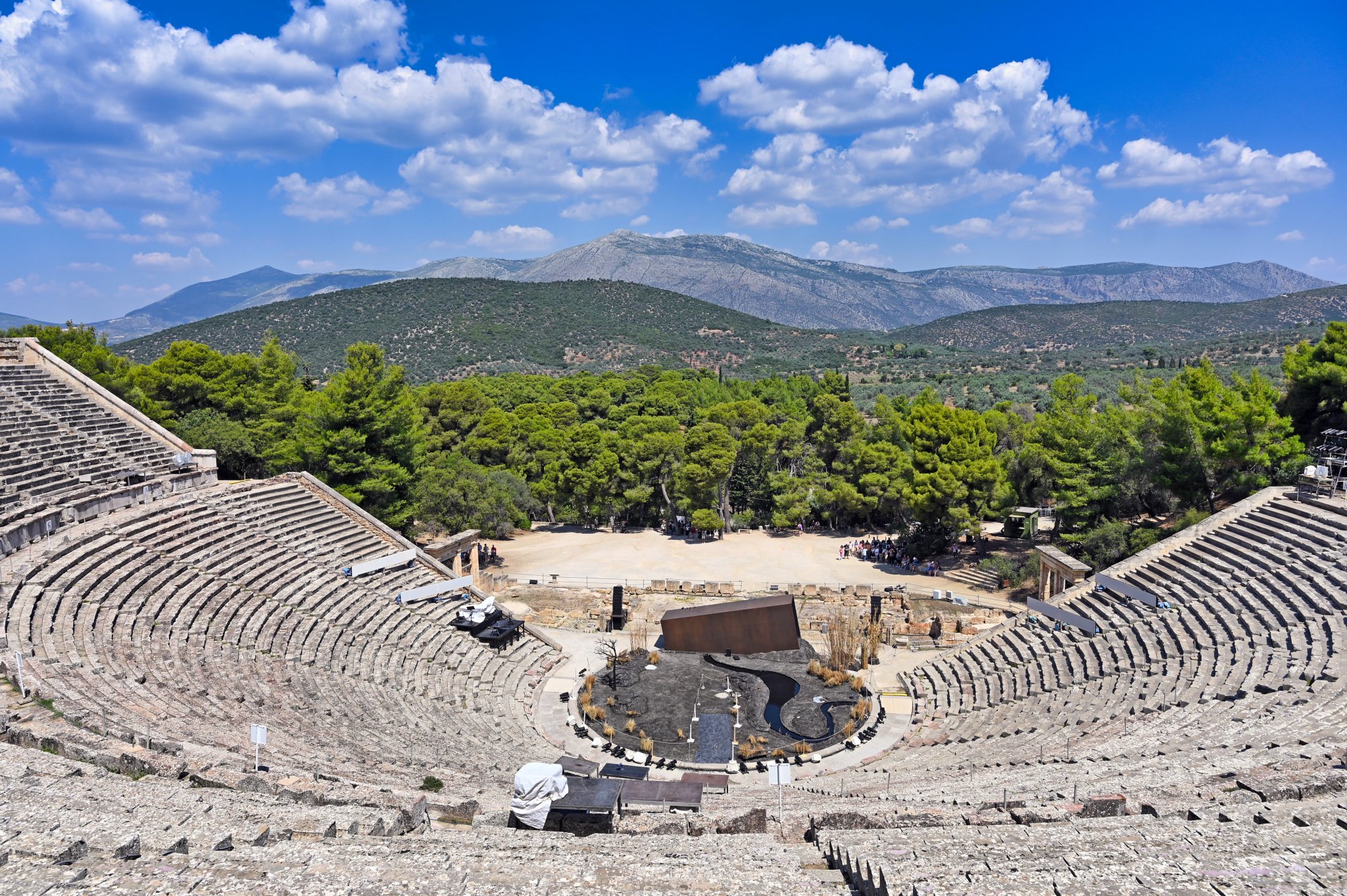
The variety of terrain means every day feels different — from seaside cruising to rewarding climbs with panoramic views. Combined with great weather, rich history, and welcoming locals, the Peloponnese is a hidden gem that rivals Europe’s most famous cycling spots.
Highlights that make the Peloponnese stand out:
- Diverse terrain: Ride from turquoise coasts to alpine villages in a single day.
- Ancient heritage: Explore Mycenae, Epidaurus, and Olympia — landmarks of Greek civilization.
- Authentic culture: Small towns, olive oil farms, and tavernas that define true Greek life.
- Low traffic: Rural roads are peaceful, with courteous drivers and plenty of space to ride.
- Rewarding climbs: Steady mountain ascents and panoramic ridge routes for confident riders.
Key Cycling Routes and Regions
The Peloponnese isn’t defined by a single long-distance trail but by a web of scenic routes linking coastlines, gorges, and timeless towns. Each area offers a different kind of beauty — from coastal rides beside the Ionian Sea to mountain ascents through the heart of Arcadia.

Top cycling routes and regions to explore:
- Sparta – Mystras – Taygetos Range: Historic roads leading to Byzantine ruins and high mountain passes.
- Corinth – Nafplio Coast: A relaxed coastal stretch dotted with fishing harbours, vineyards, and neoclassical seaside towns.
- Arcadia Mountain Route: Forested climbs, stone villages, and peaceful plateaus — the green heart of the Peloponnese.
- Kalamata – Mani Peninsula: A dramatic route between olive groves and cliffside roads, ending where mountains meet the sea.
- Olympia Countryside Loop: Quiet farmland and rolling valleys surrounding the birthplace of the Olympic Games.
When you ride with us, you don't have to choose where to go - we brought all these regions together in one ultimate ride:
Peloponnese vs. Other Greek Regions
The Peloponnese feels like Greece’s ancient heart — vast, storied, and shaped by millennia of myth and history. Technically part of the mainland, it still carries the allure of an island, separated by the Corinth Canal and surrounded by three seas. Its scale and contrasts make it unlike anywhere else in Greece: in a single ride, you can move from mountain villages to olive valleys, from classical ruins to serene coastlines.
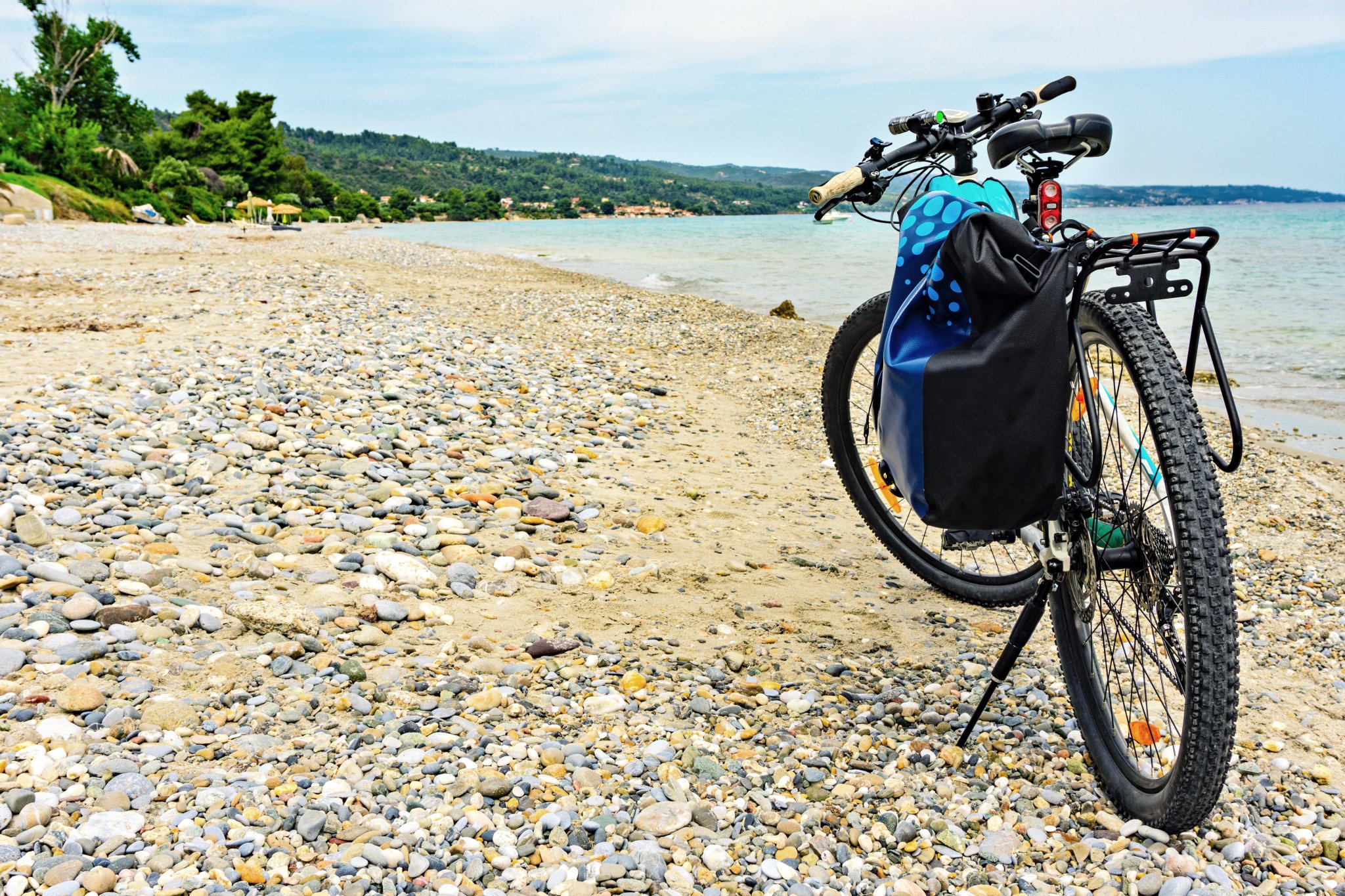
Its geography is as dramatic as its past. The towering Taygetos and Parnon ranges divide the land into distinct regions, while lush Arcadia and the rugged Mani Peninsula showcase the country’s most diverse cycling terrain. According to legend, this was where Hercules performed his labors, where Helen of Troy was born, and where the first Olympic Games took place in honor of Zeus.
From ancient Sparta to Byzantine Mystras and the timeless fishing harbors of Kardamyli and Gythio, the Peloponnese is a living museum of Greek civilization.
Local Cuisine & Culture
The Peloponnese is often called the pantry of Greece — a region where every valley, mountain, and seaside village contributes something delicious. Cycling here means tasting the country’s deepest traditions, one meal at a time.
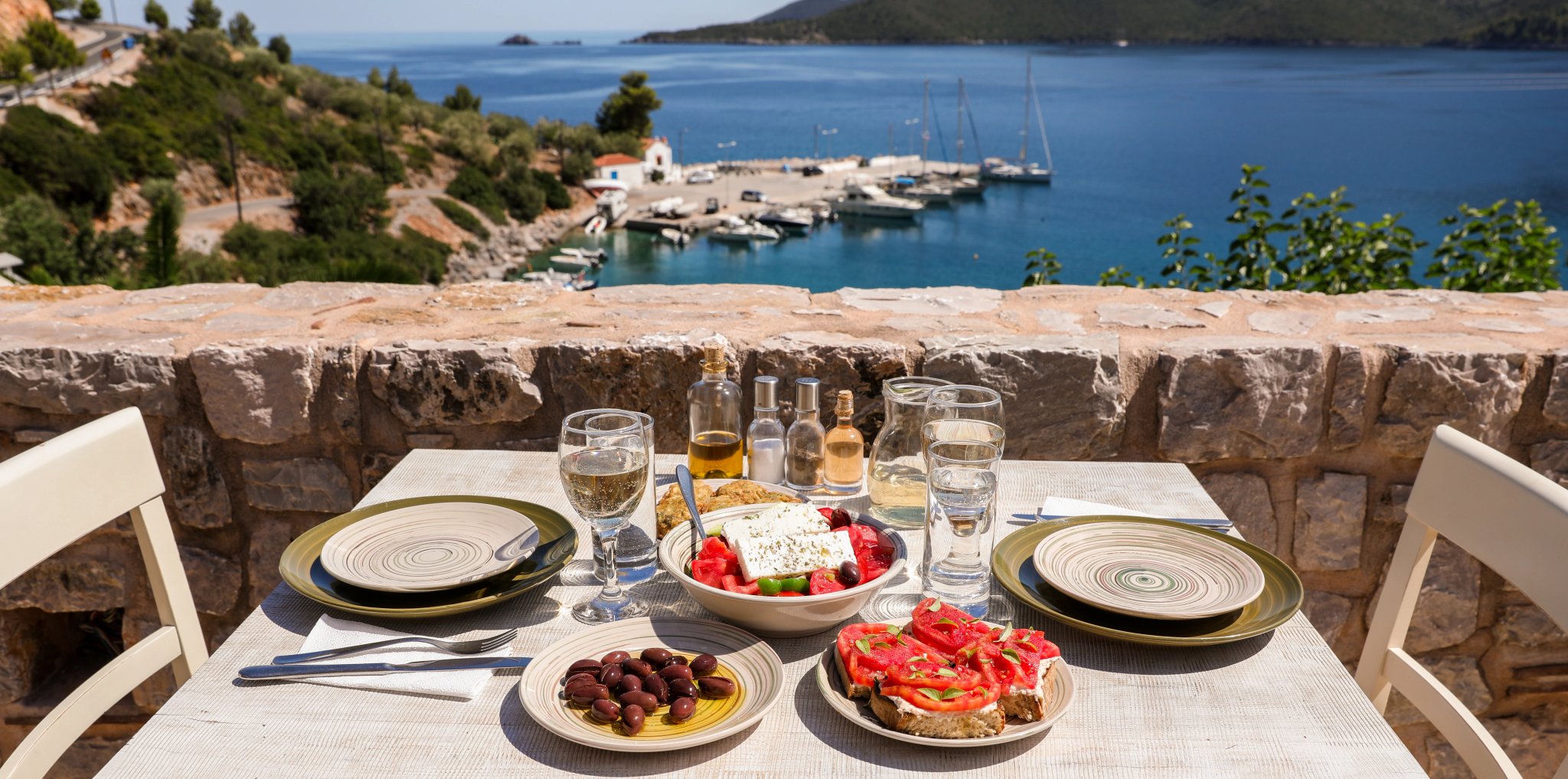
Flavors and specialties to look out for:
- Kalamata olives & olive oil: The world’s most famous variety, rich and smooth, pressed fresh each harvest.
- Arcadian honey: Fragrant, amber-colored, and used in everything from pastries to post-ride yogurt.
- Nemea wines: Full-bodied reds from one of Greece’s oldest wine regions, perfect after a long day on the bike.
- Mountain pasta (gogges): Hand-rolled noodles served with butter and cheese in the highlands of Arcadia and Laconia.
- Fresh seafood: Grilled octopus, sardines, and swordfish served in coastal towns like Gythio and Kardamyli.
- Citrus & figs: Local produce that adds brightness to every meal — or a natural snack along the road.
In the Peloponnese, food and cycling go hand in hand — both best enjoyed slowly, locally, and with good company.
For more on Greece’s regional specialties, see our greek food guide— a deep dive into the dishes, ingredients, and traditions that define Greek cycling adventures.
When to Go
The Peloponnese enjoys one of the most cyclist-friendly climates in Greece — long dry summers, mild shoulder seasons, and gentle coastal breezes that make riding possible most of the year.
Thanks to its diverse geography — from mountain passes around Taygetos to sea-level roads near Kalamata — the region offers ideal conditions for cycling between April and October.
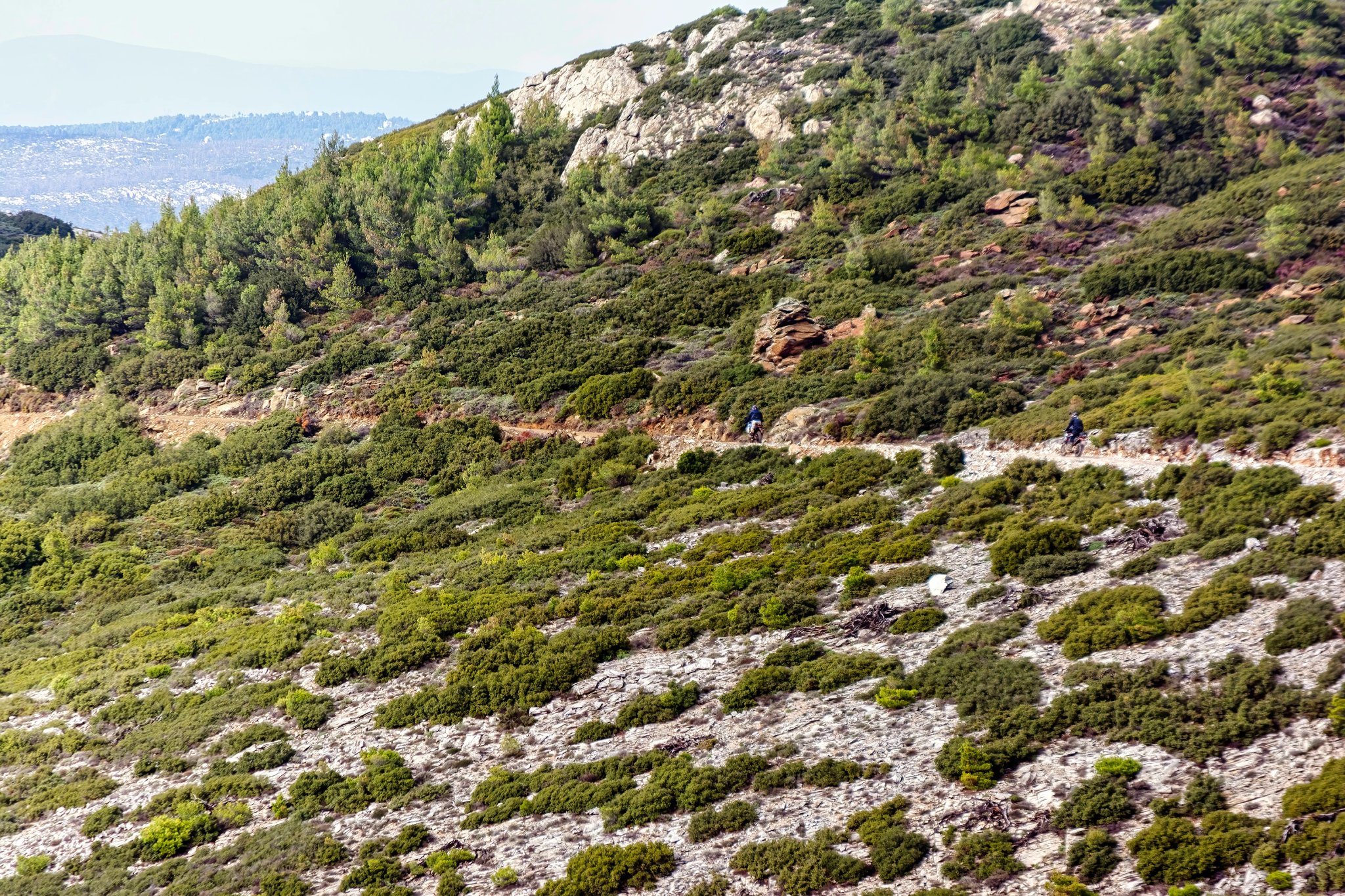
Seasonal Overview
- Spring (April–June): Wildflowers, green hills, and crystal-clear light. The best time for comfortable temperatures, quiet roads, and lush landscapes.
- Summer (July–August): Long daylight hours and fully open services — perfect for early morning rides and relaxing afternoons by the sea.
- Autumn (September–October): Warm seas, golden olive groves, and harvest season make this the most atmospheric time to cycle.
- Winter (November–March): Not recommended — some mountain roads can be rainy or windy, and many small accommodations close for the season.
Spring (April – June)

The season of renewal in the Peloponnese. Hillsides glow green, citrus groves are in bloom, and villages are lively but uncrowded.
Weather & Temperatures: Average daytime highs range between 18–25 °C, with cool evenings. Occasional light rain keeps the scenery vibrant.
Trail Conditions: Excellent — most routes are fully open and well-paved.
Why Choose Spring: The perfect balance of mild weather, clear skies, and authentic local atmosphere.
Summer (July – August)
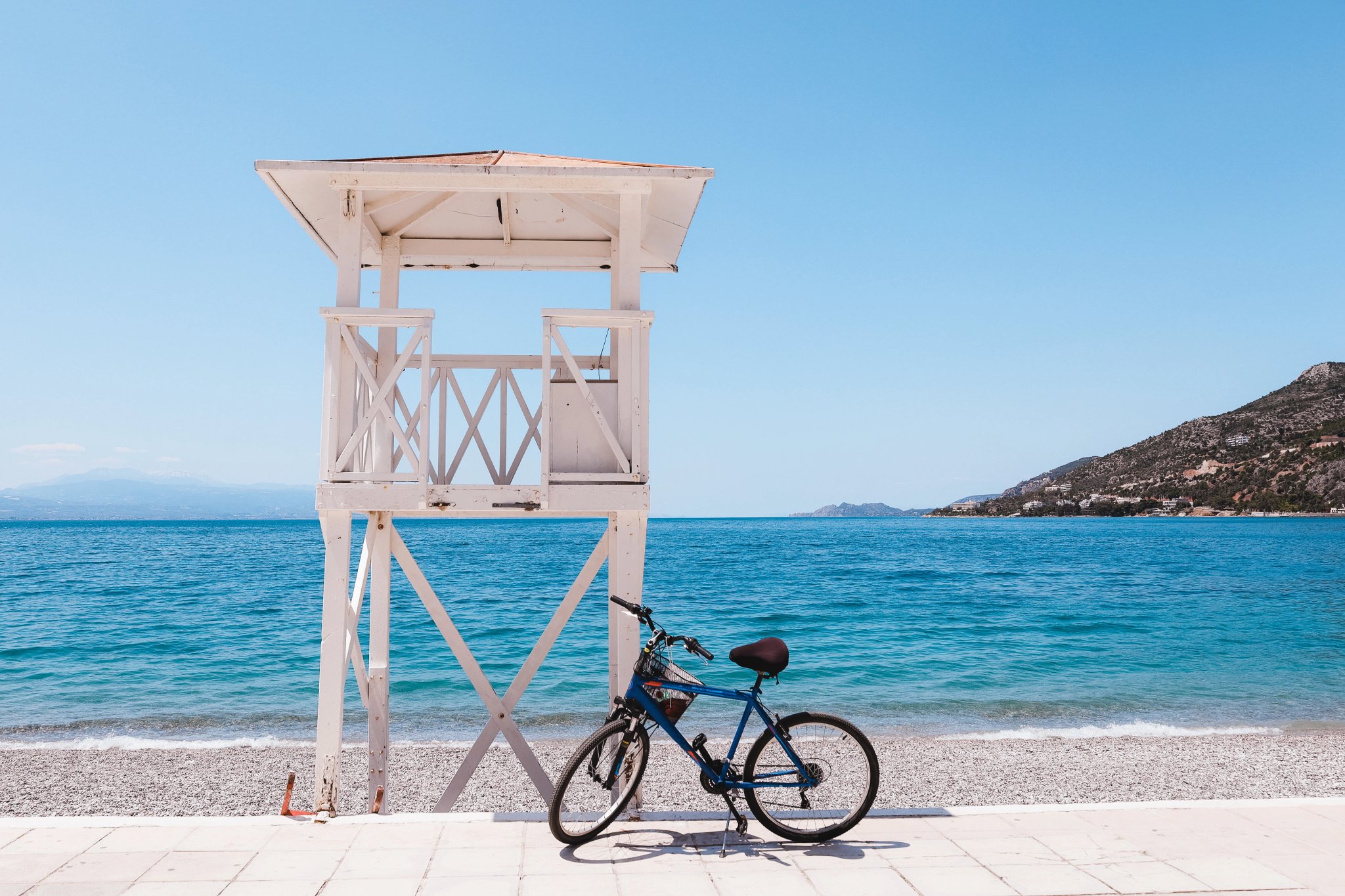
Expect classic Mediterranean sunshine — hot days, bright seas, and lively coastal evenings. Ride early or late in the day to avoid peak heat.
Weather & Temperatures: 28–35 °C on average, cooler at higher altitudes around Taygetos.
Trail Conditions: Roads are dry and fast, ideal for confident riders.
Why Choose Summer: The fullest experience — all tavernas open, beaches buzzing, and cultural festivals in full swing.
Autumn (September – October)

A golden season for cycling. Olive harvest begins, temperatures soften, and the sea remains warm for post-ride swims.
Weather & Temperatures: 22–28 °C early autumn, dipping toward 18 °C later in the season.
Trail Conditions: Excellent, with calm roads and fewer tourists.
Why Choose Autumn: Perfect for peaceful rides through sunlit olive groves and historic villages — perhaps the most photogenic time of year.
Winter (November – March)

While lowlands remain green and mild, higher terrain can be rainy or windy. Winter cycling is limited to coastal sections.
Why Skip Winter: Cooler weather (10–16 °C), shorter days, and reduced tourist services make it better suited for cultural exploration than riding.
If you’d like to know more about weather, rainfall, and daylight patterns for each month, see our Greek weather guide — a practical resource for planning your perfect time to ride.
Suggested Itinerary
Explore the timeless landscapes of the Peloponnese — from ancient Sparta and Byzantine Mystras to the rugged Mani Peninsula and coastal Kalamata. Our Best of Sparta Bike Tour connects history, mythology, and Mediterranean beauty into one unforgettable cycling adventure.
Day 1: Arrival in Sparta
Arrive in Sparta, the heart of Laconia and once the mightiest city-state of Ancient Greece. Settle into your hotel and take time to explore the town’s archaeological remains or visit the modern Museum of the Olive and Greek Olive Oil before your cycling journey begins.
Day 2: Mystras Loop Ride
Embark on a loop through the foothills of the Taygetos Mountains, tracing the history of Sparta and its medieval neighbor, Mystras — a UNESCO World Heritage Site. Ride through tranquil villages and olive groves, rewarded with sweeping valley views.
Distance: 41 km
Surface: Mostly paved rural roads with gentle climbs and smooth descents.
Elevation Profile: +340 m / -340 m

Day 3: Mystras – Gytheio
Cycle from the shadow of Taygetos to the coastal charm of Gytheio, following quiet roads lined with olive groves. Stop at the Museum of the Olive and Greek Olive Oil to learn how this region shaped Greece’s culinary legacy. Finish by the sea at Gytheio’s colorful harbor.
Distance: 64 km
Surface: Paved backroads and coastal lanes with light traffic.
Elevation Profile: +300 m / –450 m

Day 4: Gytheio – Areopoli
Ride toward the heart of the Mani Peninsula, passing traditional stone villages and scenic coastal stretches. The route winds through a landscape dotted with olive trees and historic pyrgi (tower houses).
Distance: 49 km
Surface: Mixed paved and compact gravel sections through rural and coastal terrain.
Elevation Profile: +300 m / –50 m

Day 5: Areopoli Loop Ride
Discover the hidden beauty of the Mani Peninsula on a circular route from Areopoli. Byzantine churches, rustic fishing coves, and quiet Mediterranean scenery make for a peaceful day in the saddle.
Distance: 55 km
Surface: Paved rural roads and short gravel connectors between villages.
Elevation Profile: +950 m / -950 m

Day 6: Areopoli – Kardamyli
A day of contrasts — from sea-level descents to olive-covered hills. Stop in the fishing village of Limeni before tackling a rewarding climb and descending into picturesque Kardamyli, where stone architecture meets the blue of the Messinian Sea.
Distance: 47 km
Surface: Paved with occasional rough patches on coastal and mountain roads.
Elevation Profile: +400 m / –400 m

Day 7: Kardamyli – Kalamata
Follow the coastal road north toward Kalamata, passing olive groves, small villages, and panoramic sea views. The changing terrain keeps things interesting as you transition from tranquil countryside to the lively rhythm of the city.
Distance: 45 km
Surface: Smooth coastal asphalt and rolling rural roads.
Elevation Profile: +410 m / –410 m

Day 8: Kalamata – Mystras
Return inland through olive valleys and rolling hills to the historical town of Mystras. The route combines rural beauty with glimpses of medieval fortresses and timeless Greek countryside.
Distance: 52 km
Surface: Mainly paved with light traffic; steady climbs through farmland and hills.
Elevation Profile: +1,050 m / –700 m

Day 9: Departure from Sparta
After breakfast, take time for a final stroll through Sparta or visit nearby archaeological sites before your onward journey. Transfers can be arranged to Athens or Kalamata Airport.
Highlights Along the Way
Cycling through the Peloponnese isn’t just about covering ground — it’s about immersing yourself in a landscape shaped by myth, history, and Mediterranean beauty. From mountain passes to coastal harbors, every turn reveals a new story — of Spartan strength, Byzantine grandeur, and Greek hospitality.
Here are some of the key highlights along the Best of Sparta Bike Tour — unforgettable places that capture the region’s essence:

Mystras
A UNESCO World Heritage Site, Mystras was the capital of the Byzantine Despotate of the Morea from 1349 to 1460. Its hillside ruins include palaces, monasteries, and churches decorated with 14th-century frescoes. Walking or cycling among these remains offers a vivid glimpse of late-Byzantine splendor. Mystras is often described as the “Byzantine Pompeii,” preserved in remarkable detail above the Laconian plain.

Areopoli
Areopoli, meaning “City of Ares,” lies in the heart of the Mani Peninsula, known for its stone tower houses and fierce independence. It was here, on 17 March 1821, that locals first raised the flag of the Greek War of Independence. The town’s narrow lanes lead to small squares filled with tavernas and restored stone mansions. Surrounded by olive groves and rugged limestone hills, Areopoli preserves the spirit of old Mani.

Gytheio
Once the ancient port of Sparta, Gytheio has been inhabited since Homeric times and served as a key naval base during the Peloponnesian Wars. The town stretches along a colorful harbor lined with neoclassical houses from the 19th century. Offshore, the tiny Marathonisi Island is connected to Gytheio by a causeway and features a lighthouse dating back to 1873. It’s a lively maritime stop blending Spartan history with relaxed coastal life.

Kardamyli
Set on the coast of the Mani Peninsula, Kardamyli is a quiet seaside village where stone towers rise above olive groves and turquoise waters. The old town, once a fortified settlement, still preserves its 17th-century tower houses and cobbled lanes around the Mourtzinos complex. Writers and artists, including Patrick Leigh Fermor, were drawn here for its light and unspoiled charm. Today it blends history and relaxation — swim in crystal coves, hike the Viros Gorge, or enjoy fresh seafood overlooking the Messinian Gulf at sunset.

Kalamata
Kalamata, the capital of the Messenia region, sits at the foot of the Taygetus Mountains beside the Messinian Gulf. Known worldwide for its Kalamata olives, the city’s history stretches back to ancient Pharai, mentioned by Homer. The 13th-century Castle of Kalamata overlooks a lively old town with neoclassical façades and open-air cafés. Combining mountain views, seafront promenades, and local gastronomy, Kalamata offers a well-rounded taste of southern Greece.
What to Pack for Cycling in the Peloponnese

Packing smart means making your cycling journey through the Peloponnese smooth, comfortable, and ready for its mix of mountain climbs, sun-soaked coasts, and cultural stops. The region’s varied landscapes — from the Taygetos foothills to seaside towns — call for light, breathable gear that can handle both heat and hills.
- Cycling clothing: Lightweight jerseys, padded shorts, and a moisture-wicking base layer. Include a breathable wind vest or light jacket for early mornings or descents from the mountains.
- Rain protection: A compact waterproof jacket or poncho. Showers are rare but can appear briefly in spring or autumn.
- Footwear: Comfortable cycling shoes or trainers suitable for short walks through villages and archaeological sites.
- Helmet & gloves: Essential for comfort and safety, especially on long descents or uneven rural roads.
- Navigation & accessories: GPS device or phone holder, power bank, and sunglasses for strong Mediterranean light and glare from the sea.
- Hydration & snacks: Refillable bottles and energy bars for longer stretches between villages or when exploring more remote roads.
- Evening wear: Casual clothes for dinner or an evening stroll — most towns like Kardamyli and Kalamata have relaxed yet lively tavernas.
- Documents & essentials: ID, travel insurance, small first-aid kit, and a bit of cash for local cafés or bakeries that may not accept cards.
Nice to Have
A few small extras can make your journey even smoother and more enjoyable.
- Compact bike lock: Ideal for café stops or sightseeing detours.
- Swimwear: Perfect for spontaneous dips in the sea after a coastal ride.
- Quick-dry towel or travel laundry line: Useful for multi-day tours.
- Reusable shopping bag: Great for picking up local produce, snacks, or olive oil.
- Notebook or travel journal: For jotting down memorable climbs, meals, or conversations with locals.
For more preparation tips and regional insights, see our ultimate Greek cycling guide— your complete resource for planning the perfect ride across Greece’s most inspiring regions.
Getting to the Start — Peloponnese Peninsula
Reaching the Peloponnese is straightforward, whether you’re arriving from abroad or elsewhere in Greece. The region is well connected by air, road, and sea, with smooth transfers to your starting point — and once you arrive, everything from accommodation to luggage transfers is arranged for you. All you need to do is show up and start pedalling.

By Air
- Most travellers arrive via Athens International Airport (ATH), which has direct flights from major European cities and frequent domestic connections. From Athens, you can reach the Peloponnese in a few hours by car, bus, or train — with popular gateways including Nafplio, Sparta, and Kalamata.
- Alternatively, you can fly directly to Kalamata International Airport (KLX), which serves several European routes during the summer season and offers easy access to southern Peloponnese destinations.

By Ferry
While the Peloponnese is connected to mainland Greece by road, some travellers arrive by ferry to Patras — especially those combining their trip with the Ionian Islands or arriving from western Greece. Patras is a convenient port city with easy onward connections by road to Nafplio, Kalamata, and other southern destinations.
Arrival Logistics
Upon arrival, you’ll receive a comprehensive guide, GPS routes in our simple-to-use app, and all the materials needed for a smooth, self-guided experience.
Luggage is transferred daily, allowing you to travel light and focus on the ride.
Need help arranging flights, ferries, private transfers or pre-tour stays? Simply plan a meeting with us — we’ll help design the most convenient route and make sure your Peloponnese adventure starts effortlessly.
Your Peloponnese Cycling Adventure Awaits
The Peloponnese cycling experience captures the essence of southern Greece — ancient ruins, quiet coastal roads, olive groves, and sun-soaked villages.
With our fully organized tours, you can ride freely while we handle the details — curated routes, comfortable hotels, luggage transfers, and airport pickups — so you can focus entirely on the journey.
Ready to design your perfect cycling holiday? Just contact us, and our team will tailor the ideal Peloponnese adventure — crafted around your pace, interests, and love for the open road.

Hassle-Free
We handle itineraries, accommodations, and anything else you prefer not to deal with, so you can enjoy a carefree holiday.

Completely Customizable
Flexibility is our middle name — whether you want more or less, or just beyond ordinary, we’ll make it happen.

Book with confidence
We are a financially protected company, fully bonded and insured, keeping your money safe and allowing you to travel with confidence.

Unbeatable support
Our 24/7 customer support is where we show our passion, bringing you a better experience by making your well-being our number one priority.

.jpg&w=3840&q=75)
